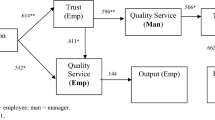Abstract
Norway’s work life is known for its strong emphasis on the collaboration between employees, unions and managers. This article explores two case studies: two companies who are part of the same group of companies with the same owners, who are introducing broad collaboration. The same process was used to change employees’ participation in the development processes, but the results were different for each company. In this article we explore the factors that influence the implementation of broad collaboration between employees, unions and managers in the light of the Norwegian work life model and of the regional traditions. When introducing new collaboration patterns between managers, union and employees in a company, it is important to take regional traditions into consideration. One of the companies succeeded in implementing direct manager-employee collaboration, and the other company failed to implement broad collaboration. This article explores the reasons behind the different results. It further explores the experience from the two cases, and asks the question is the Norwegian work life model suited for all? The article suggests strategies for how to create an environment for broad collaboration in companies that have no such tradition.





Similar content being viewed by others
Notes
NHO was at that time called NAF—the Confederation of Norwegian Employers, changed its name to NHO first January 1989.
LO—the The Norwegian Confederation of Trade Unions have 850,000 members according to their own web site.
References
Elden M (1979) Three generations of work-democracy experiments in Norway: beyond classical socio-technical systems analysis. In: Cooper CL, Mumford E (eds) The quality of working life in Western and Eastern Europe. Associated Business Press, London, pp 226–257
Emery FE, Thorsrud E (1976) Democracy at work. Martinus Nijhoff Social Science Division, Leiden
Greenwood DJ, Levin M (2007) Introduction to action research, 2nd edn. Social research for social change, 2nd edn. Sage Publications Inc, Thousand Oaks
Guba EG, Lincoln YS (1989) Fourth generation evaluation. Sage Publications, Newbury Park
Gulowsen J (1987) Kvalifikasjoner og arbeidermakt. Samlet og sterk eller splittet og svak?. Universitetsforlaget, Oslo
Gustavsen B (1992) Dialogue and development: theory of communication, action research and the restructuring of working life. Van Gorcum, Assen
Gustavsen B, Hunnius G (1981) New patterns of work reform. The case of Norway. Universitetsforlaget, Oslo
Gustavsen B, Qvale TU, Sørensen BA, Midtbø M, Engelstad PH (2010) Innovasjonssamarbeid mellom bedrifter og forskning—den norske modellen. Gyldendal Norsk Forlag, Oslo
Heron J (1996) Co-operative inquiry: research into the human condition. Sage Publications, London; Thousand Oaks
Hildrum J, Strand GL (2007) Overcoming challenges in writing about what action researchers do: the promise of the development story. Syst Pract Action Res 20(2):77–89
Huzzard T, Gregory D, Scott R (eds) (2004) Strategic unionism and partnership: boxing or dancing?. Palgrave Macmillan, Chippenham and Eastbourne
Johnsen HCG, Claussen T (2002) Democracy, participation and communicative change. When democracy becomes a means and not an end. In: Levin M (ed) Researching enterprise development. Action research on the cooperation between management and labour in Norway. John Benjamins Publishing Company, Amsterdam, pp 223–238
Klev R, Levin M (2009) Forandring som praksis. Endringsledelse gjennom læring og utvikling, 2nd edn. Fagbokforlaget, Bergen
Lawler EE III (1986) High-involvement management. Jossey-Bass, San Francisco
Levin M (2002a) Researchers on research. In: Levin M (ed) Researching enterprise development. John Benjamins Publishing Company, Amsterdam, pp 1–10
Levin M (ed) (2002b) Researching enterprise development. Action research on the cooperation between managment and labour in Norway. John Benjamins Publishing Company, Amsterdam
Levin M, Nilssen T, Ravn JE, Øyum L (2012) Demokrati i arbeidslivet. Den norske samarbeidsmodellen som konkurransefortrinn. Fagbokforlaget Vigmostad and Bjørke AS, Bergen
Lewin K (1946) Action research and minority problems. J Soc Issues 2(4):34–46
Løseth A (2004) Region, kultur og økonomi—Nord-Vestlandet 1850–1975. In: Gammelsæter H, Bukve O, Løseth A (eds) Nord-Vestlandet—liv laga?. Sunnmørsposten Forlag, Ålesund, pp 22–51
Lysgaard S (1961) Arbeiderkollektivet (3–2001 edn). Universitetsforlaget, Oslo
Martin R, Sunley P (2006) Path dependence and regional economic evolution. J Econ Geogr 6(4):395–437
Meyer CB, Stensaker I (2011) Endringskapasitet. Fagbokforlaget, Oslo
Nelson RR, Winter SG (1982) An evolutionary theory of economic change. The Belknap Press of Harvard University, Cambridge
Nergaard K, Stokke TA (2006) Organisasjonsgrader og tariffavtaledekning i norsk arbeidsliv 2004/2005, [518]. Fafo, Oslo
Øyum L, Finnestrand HGO, Johnsen E, Lund R, Nilssen T, Ravn JE (2010) PALU: utvikling og praktisering av den norske samarbeidsmodellen. SINTEF, NHO, LO, Hovedorganisasjonenes Fellestiltak, Trondheim
Pateman C (1970) Participation and democratic theory. Cambridge University Press, Cambridge
Reason P, Bradbury H (2008) Introduction. In: Reason P, Bradbury H (eds) The SAGE handbook of action research. Participative inquiry and practice, 2nd edn. Sage Publications, Los Angeles, pp 1–13
Schramm-Nielsen J, Lawrence P, Sivesund KH (2004) Management in scandinavia. Culture, context and change. Edward Elgar Publishing, Cheltenham
Stake RE (1995) The art of case study research. Sage Publications, Thousand Oaks
Strand GL (2011) Reorganising the workplace: factors that affect implementation of broad participation. Norges teknisk-naturvitenskapelige universitet, Trondheim
Strand GL, Skogseid I, Hildrum J (2004) WISS kartleggingskonferanse, VF notat 13/2004. WISS, Sogndal
Wicken O (ed) (1997) Regionenes industrialisering: et historisk perspektiv. Høyskoleforlaget, Kristiansand
Wicken O (1998) Regional Industrialization and political mobilization: regions in political party system and industrialization in Norway. Comp Soc Res 17:241–271
Yin RK (1981) The case study as a serious research strategy. Knowledge 3(1):97–114
Author information
Authors and Affiliations
Corresponding author
Rights and permissions
About this article
Cite this article
Strand, G.L., Skogseid, I. Management and Employees’ Collaboration: Is the Norwegian Work Life Model Suited for All?. Syst Pract Action Res 26, 53–74 (2013). https://doi.org/10.1007/s11213-012-9269-1
Published:
Issue Date:
DOI: https://doi.org/10.1007/s11213-012-9269-1




